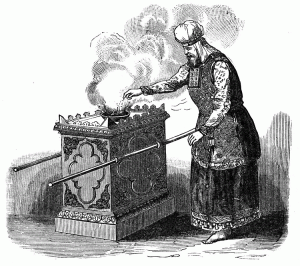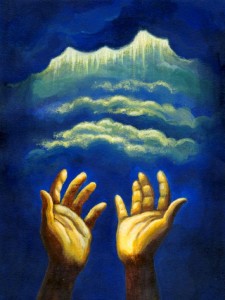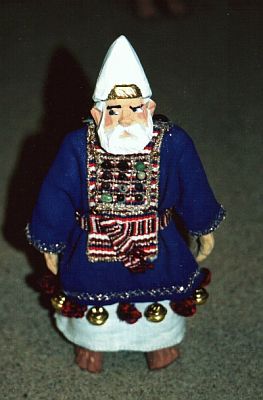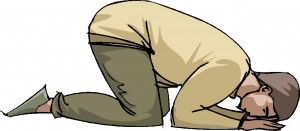Exodus 28 and Exodus 29 (also Lev 8)
Now let’s note the seven steps of consecrating the priests and compare them with the steps a believer goes through to become a “chosen generation, a royal priesthood, a set-apart nation, a peculiar people that you should show forth the praises of him who has called you out of darkness into his marvelous light” (1 Pet 2:9). Notice how the seven steps relate to the steps a new believer takes in his conversion process and how they relate to one’s spiritual journey from outside the mishkan where the altar of the red heifer is located representing the cross of Yeshua, then into the door of the tabernacle (i.e., Yeshua who is the door), to the altar of sacrifice (i.e., a prophetic picture of communion) to the bronze laver (i.e., immersion for the remission of sins and being washed in the water of the Word of YHVH), into the set-apart place where the Ruach (Spirit of Elohim) is and onward and upward spiritually into intimate relationship with the Father. In Exodus chapters 28 and 29 we find the following:
Step One: They were taken from among the children of Israel ( Exod 28:1). This prefigures divine election (see John 15:16). YHVH calls or chooses each person. Yeshua called his disciples. They did not call or choose him, but they had to respond to that call.
Step Two: They were brought into the door of the tabernacle (Exod 29:4). The door of the tabernacle is Messiah Yeshua who is the door to the sheepfold. No man comes to the Father except through Yeshua (John 10:1–5, 7, 9) The door is four colors which speak of the person and work of Yeshua: blue, scarlet, white and purple. It also speaks of the four Gospels, which is the door to understanding the Person and work of Yeshua.
Step Three: They were washed (Exod 29:4). Upon accepting the work and Person of Yeshua one must be immersed for the remission of sins (Acts 2:28) to identify spiritually with the death, burial and resurrection of Yeshua (Acts 2:38; Rom 6:3–14), and the washing of the water of the Word (Eph 5:26).
Step Four: They were clothed in their official garments (Exod 29:4–9). The redeemed believer is to put on the robes of righteousness (note Gal 3:27, “For as many of you as have been baptized into Messiah have put on Messiah”). Paul talks about fruits of righteousness through Yeshua in Philippians 1:1. Righteousness is Torah obedience (Ps 119:172) and is a mark of the end time believers/saints (Rev 12:17 and 14:12) and of the bride of Messiah (Rev 19:8).
Step Five: They laid their hands on the head of the animals which were sacrificed. The blood was shed and sprinkled on Aaron and his sons and matzah (unleavened bread) was waved and burnt and they ate the flesh of the ram and the matzah (Exod 29:10–26, 32–33)
Each born-again believer has to take personal responsibility for his own sins. The sacrifice of Yeshua, the Lamb of Elohim, at the cross must become personal to each person (see Heb 10:19; 13:12; 1 Pet 1:2; 1 John 1:17 and Rev 1:5). Each believer has his own personal relationship with Yeshua. Each must eat the flesh and drink the blood of Yeshua individually (John 6:35–58). Communion is a personal and individual matter.
Step Six: They were anointed with oil (Exod 29:21). Each person must receive the Set-Apart Spirit (Ruach) of Elohim (see Acts 8:17; 19:6).
Step Seven: They are sanctified or set-apart for a special, divine purpose (Exod 29:44). Only after going through these steps is one set-apart unto YHVH as a set-apart priesthood doing the set-apart work of YHVH (see Rom 15:16; 1 Cor 1:2; 6:11; Heb 10:10,14; 1 Pet 2:9).
Only on the basis of following YHVH’s steps, as outlined above, can one have fellowship with the Father. And what was the result of this consecration process? Relationship with the Father! Read Exodus 29:44–46 below,
And I will sanctify the tabernacle of the congregation, and the altar: I will sanctify also both Aaron and his sons, to minister to me in the priest’s office. And I will dwell among the children of Israel, and will be their Elohim. And they shall know that I am YHVH their Elohim, that brought them forth out of the land of Egypt, that I may dwell among them: I am YHVH their Elohim. (emphasis added)
This is all accomplished through Yeshua living in us spiritually. Yeshua is the Chief Cornerstone of our faith (Eph 2:20). He is the end result or goal of the Torah (Rom 10:4). He is the Author and the Finisher of our Faith, the Beginning and the End, the Aleph and Tav (Alpha and Omega) of everything.
To whom coming, as unto a living stone, disallowed indeed of men, but chosen of Elohim, and precious, you also, as lively stones, are built up a spiritual house, a set-apart priesthood, to offer up spiritual sacrifices, acceptable to Elohim by Yeshua the Messiah. Wherefore also it is contained in the Scripture, “Behold, I lay in Tzion a chief corner stone, elect, precious, and he that believes on him shall not be confounded. Unto you therefore which believe he is precious, but unto them which be disobedient, the stone which the builders disallowed, the same is made the head of the corner, and a stone of stumbling, and a rock of offence, even to them which stumble at the word, being disobedient: whereunto also they were appointed. But you are a chosen generation, a royal priesthood, a holy nation, a peculiar people; that ye should shew forth the praises of him who has called you out of darkness into his marvelous light, which in time past were not a people, but are now the people of Elohim, which had not obtained mercy, but now have obtained mercy. (1 Pet 2:4–10)
Our faith in Yeshua stays alive and vibrant because of the sacrifices of devotion and praise we offer up daily, morning and night. We are called to do the same work the priests of old did, but in a spiritual or fuller sense.






